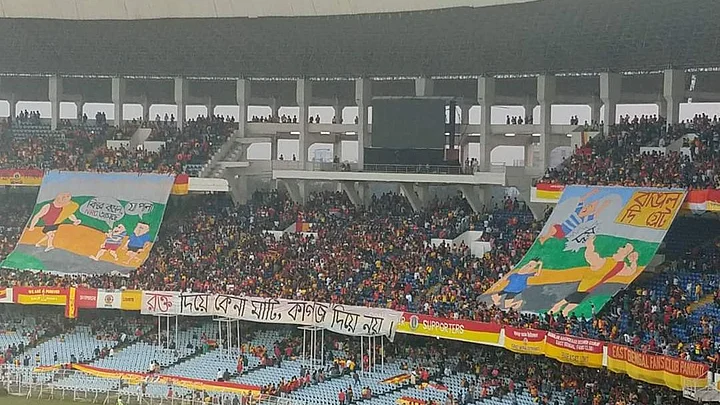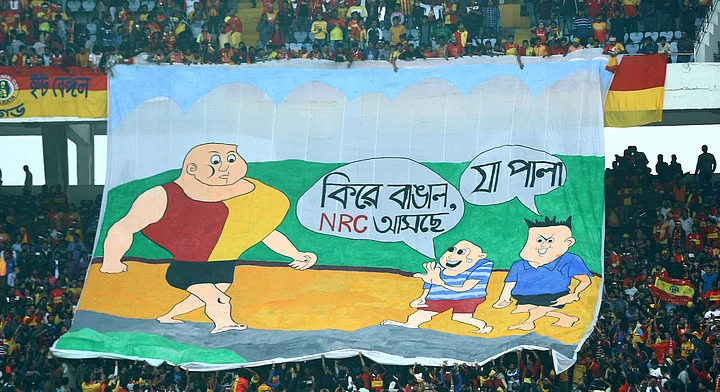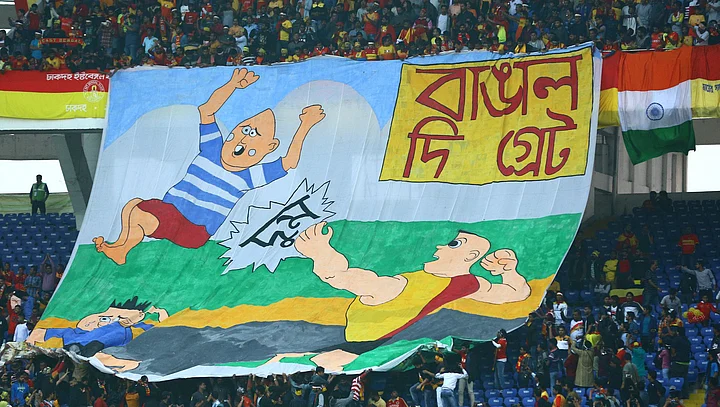East Bengal versus Mohun Bagan derbies have a history of making headlines off the field as much as on it. Sunday, 20 January, was yet another occasion.
Five minutes before Indian football’s biggest rivals kicked off at Kolkata’s iconic Salt Lake Stadium, a brigade of ardent East Bengal supporters unfurled a series of banners that stole the headlines from the final scoreline.
As players of both clubs emerged from the tunnel to a deafening roar of 63, 756 strong crowd, a 1000-square-feet banner from the red-and-golden end of the stadium read aloud:
Rokto Diye Kena Maati, Kaagoj Diye Noi (Land bought with blood, not with papers.)
For East Bengal Football Club, which celebrates its centenary this year, the political has often been personal. While most supporters trace their roots to present-day Bangladesh, the club itself has been shaped by partition and the displacement of refugees.
Mohun Bagan supporters, on the other hand, boast a ‘ghoti’ support base (those from central, south West Bengal).
With Anti-CAA, anti-NRC movements rapidly gaining ground across India, East Bengal supporters say that this has once again opened old wounds of identity and ‘Indian-ness’.
“For long we have been taunted regularly by supporters of rival clubs as ‘refugees’, as “Bangladeshis” and as those who have crawled into India from beneath the barbed wires,” 27-year-old Hrisav Bhowmick, one of the supporters behind the banners, told The Quint.
“These taunts have intensified since CAA-NRC came into news. Be it on the ground or on social media this has now become regular,” Bhowmick added.
Bhowmick is a member of East Bengal Ultras, a passionate fan movement popular for its vocal support and the brains behind the creative tifo ( a choreographed display to form a large image or sign ).
Not About Politics But Identity
East Bengal versus Mohun Bagan clashes have always been emotionally charged with vociferous supporters of the two clubs on opposite ends of the stadium. While the Bagan end is a hue of maroon-green, the East Bengal end is awash in red and gold.
The giant tifos, in this regard, must be giant enough to convey its message to the other end of the stadium.
“Our intention was not to bash any political party. There is no political agenda to our statement,” said Sayan Sarkar, a senior member of East Bengal Ultras.
Those behind the banner say that the tifos were conceptualised to make a statement about the identity of the club’s supporters and the heritage of the club, founded on 1 August 1920 and among the most successful in India’s football history.
“On various occasions and in various ways since NRC came in the news, we have been told we will soon have to run way to Bangladesh. Our message is mainly about anti-racism,” Sarkar added.
Accompanying the statement were two giant banners featuring Bengal’s most loved comic superhero – Batul The Great. While one banner showed Batul’s nemesis taunting him for being a “Baangaal” (from eastern Bengal, now Bangladesh), the second banner shows Batul sending his nemesis flying with a punch.
Soumya Dasgupta, 33, a passionate East Bengal supporter now based in London noticed the banners while watching the Kolkata derby online. “Knaata Taar Er Daag” (scars from barbed wires) – the term in Bengali has a deep impact on the mind of East Bengal supporters because they had to cross borders to settle in this part of the country during the partition.”
“Being a die-hard East Bengal supporter, I have a tattoo of a barbed wire on my back which I flaunt proudly,” Soumya told The Quint.
Executing a 7,000 Square Feet Banner
How does one go about making a tifo the size of three tennis courts?
Banti Ghosh, 25, a member of East Bengal Ultras describes how the tifo was conceptualised and implemented.
“We have three teams – the designing team, painting team and execution team – working behind any of the tifos we have come up with,” Ghosh told The Quint.
The work for the giant tifo had started in the second week of November itself, a month before the Citizenship Amendment Bill was passed in Parliament. The Mohun Bagan vs East Bengal derby was originally scheduled for 22 December but was postponed to 19 January.
“A team of about 35 people worked on the tifo for over a month and it was completed on 19 December,” said Ghosh.
“The match got postponed but Citizenship Amendment Act was passed in the meantime and a lot of water has flown since then and this banner has become more topical now than it would’ve been had it been played in December,” said Bhowmick
Tackling CAA-NPR-NRC
Members of East Bengal Ultras, however, strongly maintain that their intention was not to make a pointed political statement or politicise a sporting arena.
“While NRC-CAA provide the context for the banner our statement is against those who ridicule our history. We do not wish to drag politics into football,” said Banti Ghosh.
Fans of the club who worked on the banners pointed out that they took care not to mention any political party, their rivals Mohun Bagan. However, they also added that there is no ambiguity in what they aim to convey.
An official statement from the Ultras clarified that “we have raised our statement against them who keep on intimidating/ threatening us by calling us ‘Bangladeshis’ and what not.”
“NRC CAA is a complicated affair but what Ultras did in the Kolkata derby is highly commendable because of the fact that football can’t be alienated from issues like this which has millions of Indians in a fix,” Dasgupta, London-based senior scientist.
In the 90 minutes on the pitch, Mohun Bagan edged past East Bengal 2-1.


